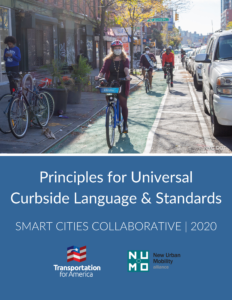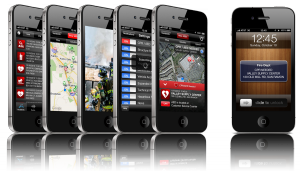
Cities and towns face a massive hurdle to managing their curb space: the lack of a uniform way to define the curb and its users. Without a universal curb standard, it’s difficult for local governments to coordinate with each other and private entities and assess the effectiveness of their curbside management policies. Participants in our Smart Cities Collaborative joined together to develop five principles that should inform any universal curbside language and standards.
Demands on the curb have skyrocketed in the last decade, while the amount of curb space has largely remained the same. Due to increased vehicle congestion, commerce delivery, the increase in parklets and outdoor dining, and access to modes like shared bikes and scooters and app-based ride-hailing, the curb has become a scarce and sought-after resource.
Curbs are no longer simply for parking. They’re key to the movement of goods and people, and now even our COVID-19 response. The pandemic has only crystallized the importance of the curb, as an exponential amount of curb space has been needed for safe recreation, retail, restaurants, and more.
Yet curbs are massively underutilized by cities and towns. Although many local governments have created or are in the process of creating strategies to manage curb space, there is no uniform way that local governments define the curb and its users. This makes it difficult for local governments to assess the effectiveness of their curbside management policies—to truly utilize curb space for the public good—because there isn’t a uniform way to evaluate data or share lessons learned with other municipalities.
That’s why participants in our Smart Cities Collaborative joined together to create five principles that should inform the development of any universal curbside language and set of standards. These five principles for a national standard will ensure that the public interest is embedded within the standard and language itself, giving cities and towns a shared definition of the curb and its users while empowering them to customize curbside management to best serve the unique needs of their residents.
Here’s a quick summary of our five principles for a universal curbside language and standards (UCLS). You can read much more in-depth on these principles and the need for a UCLS created by the public sector in our new report, “Principles for Universal Curbside Language & Standards.”
PRINCIPLE 1 | LOCAL PUBLIC AGENCIES SET THE POLICY
A successful UCLS will be one that is shaped by the public agencies who manage the curb.
Curbs within the public right-of-way are funded and regulated entirely with public funding and should serve community needs. For that reason alone, local public agencies—who are in charge of the curb—are best suited to lead this effort.
While input and data from private companies—especially freight operators—is important, creating a language and standards that caters primarily to the needs of any one stakeholder would be a disservice to all users, especially the most vulnerable.
PRINCIPLE 2 | EQUITABLE
The design of a UCLS is an opportunity to assist local governments in their effort to shift and reallocate curb space from being a free resource that serves few (primarily through car parking) to a resource that serves everyone—especially those who deserve better and more affordable access to curbs. This includes people with disabilities, people using transit; those walking, biking, or rolling; low-income people; Black, Indigenous, and people of color; and those not connected to the digital network.
Equity must be embedded within any UCLS so that local governments can prioritize their most vulnerable right-of-way users and disadvantaged community members. You can check out our recommendations for incorporating equity into a UCLS in our full report.
PRINCIPLE 3 | OPEN & PUBLICLY OWNED DATA
Any UCLS needs to be developed with an open data approach where public agencies own the data and data is collected and shared in a secure and transparent manner that protects personally identifiable information. Open data provides transparency and ensures data can be freely used, re-used and redistributed by anyone. Public agencies—or non-profits or academic institutions—need to be the stewards of any and all curbside data.
You can read the metrics we recommend a UCLS track in our full report.
PRINCIPLE 4 | EASILY TRANSFERABLE
To be truly universal, the language and standards must be easily accessible, understandable, and transferable to communities of all sizes, land uses and street typologies, and densities. A scalable and customizable UCLS based on a jurisdiction’s resources, tools, and capabilities ensures mass buy-in, giving local governments the ability to share lessons learned from curbside management in the same language.
PRINCIPLE 5 | CLEARLY COMMUNICATED
There was a considerable shift in how the curb has been used in the last decade, and in the last two years in particular due to rapid changes like the growth in e-commerce. This presents a unique opportunity for local governments, as the stewards of the curb, to rethink how to internally and externally communicate the value and importance of the curb and the benefit of a UCLS.
Internal and external curb stakeholders must understand—through a UCLS—the changing nature and value of the curb, as well as the short and long-term benefits of more proactive curbside management.
Final thoughts: it’s critical that universal curbside language and standards are created by the public sector, for the public
The curb is public space and a public asset, and as such it should be utilized to the greatest benefit of the public. It is the responsibility of local governments to prioritize who can use the limited amount of curb space, for what and when. Because of the many demands on the curb, without regulating and prioritizing access, our curbs cannot reflect or respond to the rapidly changing needs of the city and its users. And without applying an equity lens to prioritization of curbspace, certain users (such as people who do not own, cannot afford, or are unable to drive cars) will continue to be left behind as they do not benefit from “free” parking.
That’s why it’s critical that the public sector informs the creation of any universal language and standards. We hope that these principles can help shape any and every UCLS to come.





 We’re no stranger at T4 America to the idea of using open government data to help ordinary citizens better understand their transportation system and how federal and local transportation policy needs to change to make them safer. We’ve regularly used public data from the U.S. Department of Transportation to seed useful tools, like the interactive map of ten years of pedestrian fatalities (
We’re no stranger at T4 America to the idea of using open government data to help ordinary citizens better understand their transportation system and how federal and local transportation policy needs to change to make them safer. We’ve regularly used public data from the U.S. Department of Transportation to seed useful tools, like the interactive map of ten years of pedestrian fatalities (